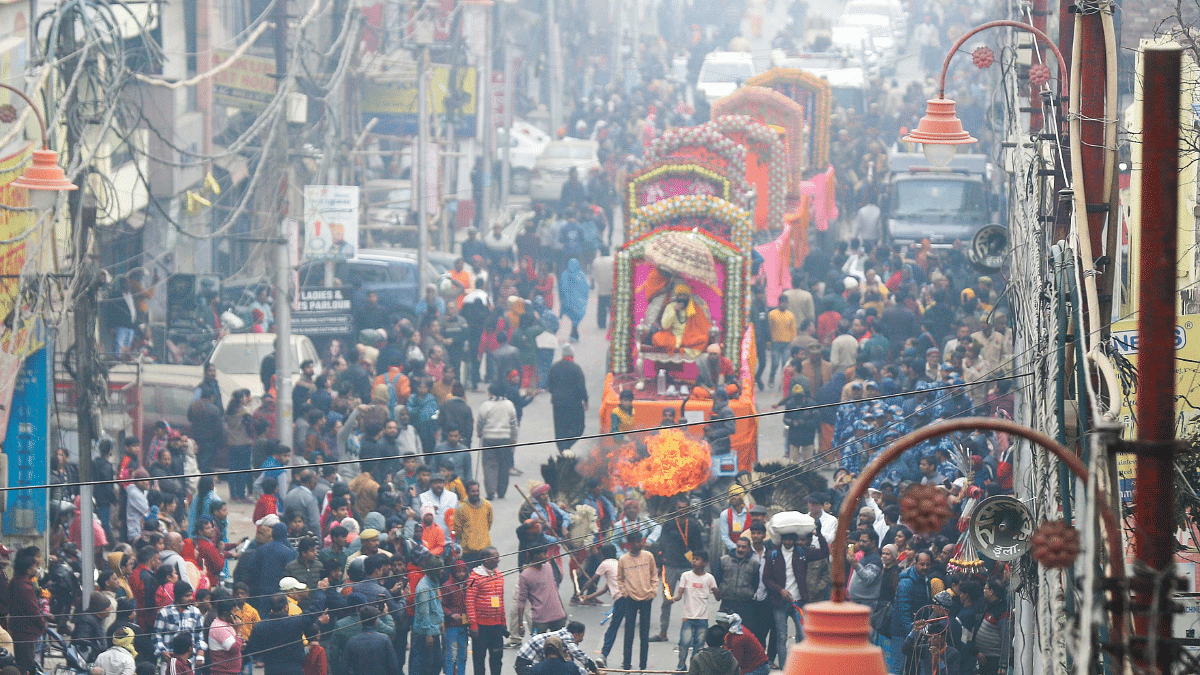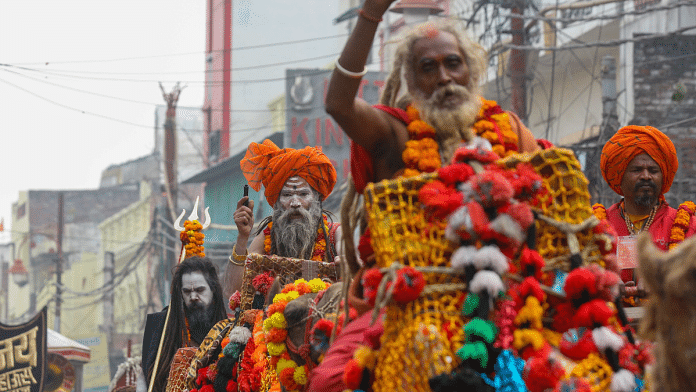Prayagraj: Sadhus perched high on camels, elephants, and ornate chariots make way as the procession slowly snakes through the narrow roads. Desirous of getting their blessings, devotees jostle and push each other to get nearer a moving chariot, scrambling to reach the feet of holy men sitting there.
The sadhus raise their hands in blessing—some lighting ‘chillum’ (clay pipe) as they ride camels, others wielding tridents and maces, with their hard gazes staring at the sea of folded hands.
Marigold flowers and candies fly through the air as sadhus toss them with a deep, throaty laugh, while devotees rush to collect the sacred petals amidst the blaring of trumpets, rolling of drums and music bands. Policemen on horseback escort the procession as the Peshwai—a grand ceremonial spectacle marking the arrival of an akhara to the Maha Kumbh—brings crowds to a standstill.
Such a rich display of tradition and religion will repeat more as the Maha Kumbh is a day away. But beyond this religious grandeur lies a thriving economy. One Peshwai involves over Rs 10 lakh of investment, going by the chatter among the organisers, for a procession that runs on to 2-3 km.

And for countless individuals like Nagender Kumar Yadav, the Peshwai is more than just a tradition—it’s an opportunity to earn. From craftsmen performers, camel and elephant handlers to chariot makers, operators, and band members, the Maha Kumbh marks the arrival of earning opportunities albeit for a brief period.
Yadav has been handling a camel for the Panchayati Akhara. During lean days, he earns between Rs 1,000 and Rs 1,500. “But for the Maha Kumbh, I’m making Rs 3,500 for six hours,” says the 28-year-old from Jaunpur, as he helps children to touch the camel for blessings.
“With the seers sitting on camels, even folks like him have become gods for a day in the eyes of the devotees,” Yadav chuckles.
And the reach of the Peshwai transcends religious boundaries, too. Mohammad Afsar has been playing his trumpet for the past four hours as he marches alongside the Peshwai. The 48-year-old traveled from Delhi to perform at the religious procession.
“I’m an artist. The band approached me, so I came,” says Afsar, sipping a hot cup of tea as the procession paused for the devotees.

Vinay Kumar Singh, who has been pushing the carts replete with the tricolour, says that he earns Rs 400 for this work. “On normal days, Rs 400 comes by after doing odd jobs for two-three days. At Peshwai, it’s easy to earn,” Singh, a resident of Ranipur, admits.
Singh plans to stay in Maha Kumbh till 16 January, even after the first shahi snan (royal bath), with a hope that he would make more money. “I heard from my friends who are working here that there is a lot of employment at Kumbh. So I will try my luck too,” he smiles.
Odd jobs spring up as well, and in plenty, as the world descends on Prayagraj for the world’s largest religious congregation. Over 40 crore of devotees are expected to congregate for a period lasting a little over a month, according to the Maha Kumbh organisers.
Similarly, Suman, 42, came from Haryana’s Sonipat 15 days ago. Now, she sits outside the Hanuman temple near the fort made by Mughal emperor Akbar, selling toys laid out on a piece of cloth.
A toy seller back in Haryana, Suman and her husband decided to take the train to Prayagraj after hearing about earning opportunities from workers from Uttar Pradesh working in Haryana. She joined them on their journey back to their home.
“There are so many people coming here. I make around Rs 1,000 a day. It’s all because of God,” she said.

Holding an aluminium kettle in the morning cold, Mohammad Yunus sells tea at the Maha Kumbh. The 34-year-old from Muzaffarnagar doesn’t care about politics of the day. On a given day, he easily earns Rs 3,000-Rs 4,000. “Everyone loves tea. I respect Hindus but for me, it’s a job opportunity. And I will stay here for an entire month.”
Mohammad is staying at a regular tent set up by the authorities for people who can’t pay for luxury tents. Surely to pay Rs 50 per day, or Rs 100 on peak days, the tea seller doesn’t mind shelling that amount for modest accommodation replete with a basic mattress and a blanket.
Similarly, 25-year-old Sunny bought an electric rickshaw last month to drive during the Maha Kumbh for which he learnt how to drive the ‘toto’. Sensing an opportunity to earn, he took a bank loan of Rs 1.5 lakh from the bank.
Previously earning Rs 500 a day as a plumber, the Prayagraj local now earns Rs 2,000-Rs 2,500 per day, and sometimes even more. He intends to clear the loan and save up for his brother’s education.
“My plan is to earn as much as I can in this month and a half and save it to pay for my brother’s education, so he doesn’t have to struggle like I did,” he says, with a touch of reflection in his voice.
Back at the procession, Afsar is hardly perturbed by the incidents like in Sambhal where clashes brought the sharp social divide to the fore. His work as a musician is his bread and butter, he adds.
“I am the testament to Hindu-Muslim unity. Let the politicians play their games. My Bharat is united,” he said emphatically, before he joined the band to play the popular 1960s song of Mohammed Rafi’s ‘Woh Bharat Desh Hai Mera’.
(Edited by Tony Rai)







The Kumbh Mela is the largest congregation of disbelievers (Kafirs) on earth.
It presents the perfect opportunity to the believers to preach and propagate the message of Allah to the Kafirs. The Imams and Maulanas must engage with the kafirs and make them understand that Islam is the only true religion.
biggest jumla of the century Hindu Muslim Bhai Bhai 🤡 if you want to report do it why propagate propaganda . Mughal build temple 🤣 fake. like recently exposed muslim female teacher.